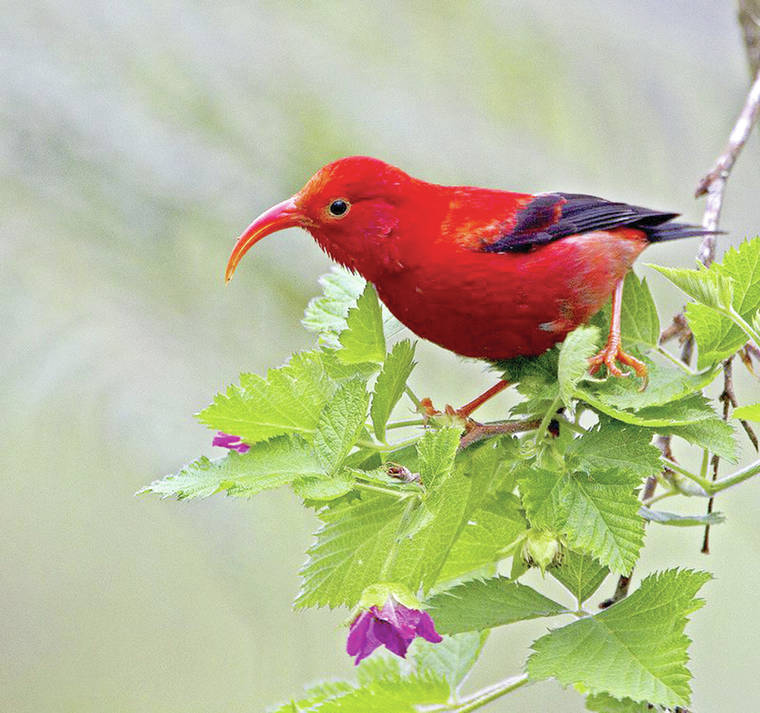HONOLULU — The Center for Biological Diversity today filed a formal notice of intent to sue the U.S. Fish and Wildlife Service for failing to designate critical habitat and develop a recovery plan for the threatened ‘i‘iwi, the best known of Hawai‘i’s imperiled honeycreepers.
Due to the extensive threats of mosquito-borne diseases, such as avian malaria and avian pox, rapid ‘ohi‘a death and climate change, the Service listed the ‘i‘iwi as threatened on Sept. 20, 2017. The Endangered Species Act required the agency to designate critical habitat with its listing determination and develop a recovery plan for the bird. Yet the Service has failed to do so.
“The Fish and Wildlife Service’s unacceptable delay deprives ‘i‘iwi of badly needed protections,” said Maxx Phillips, the Center’s Hawai‘i director and staff attorney. “Without an actual recovery plan and protected habitat, these beautiful birds likely won’t survive.”
The ‘i‘iwi, the iconic bright red honeycreeper, was once one of the most abundant native forest birds in the state. Today, it can no longer be found across much of its historical range. The introduction of invasive mosquitoes and mosquito-borne diseases have wiped out most native Hawaiian forest birds from lowland forests.
‘I‘iwi are highly susceptible to avian malaria, with approximately 95% mortality when infected. The combination of low resistance and high mortality means that nearly every ‘i‘iwi that comes into contact with avian malaria dies from the disease.
Since mosquitoes cannot survive at higher elevations due to cooler temperatures, ‘i‘iwi have sought refuge in higher-elevation forests. However, as the impacts of global climate change continue to accelerate, temperatures at higher elevations in Hawai‘i are increasing at an unforeseen rate.
Warmer conditions allow mosquitos to invade mid- and high-elevation forests, resulting in the spread of malaria to the last remaining populations of these threatened birds. For example, on Kaua‘i, where warmer temperatures now allow mosquitoes to survive at all elevations, ‘i‘iwi are expected to go extinct by 2050.
Alongside the devastating impacts of mosquitoes and climate change, rapid ‘ohi‘a death, an invasive fungal disease that is killing ‘ohi‘a trees at an alarming rate, is further threatening the ‘i‘iwi’s survival. ‘I‘iwi depend on the ‘ohi‘a for nesting and foraging, surviving primarily on the nectar from lehua blossoms.
Though originally limited to the island of Hawai‘i, as of June 2020, rapid ‘ohi‘a death has spread to Kaua‘i, Maui and O‘ahu. With no effective means of containing the disease, ‘ohi‘a forest death poses a significant risk to the continued survival of the ‘i‘iwi.
Listing the ‘i‘iwi as threatened was just the first step in ensuring its survival and recovery. Species without designated critical habitat are half as likely to move toward recovery as species with critical habitat. Without protections for its critical habitat, the ‘i‘iwi will continue to lose what little disease-free habitat remains.
Additionally, species with timely recovery plans for two or more years are far more likely to improve than those without.
Recovery plans are the main tool for identifying actions necessary to save threatened species from extinction. Timely development and implementation are critical to saving species, as the plans identify on-the-ground, necessary actions to save species. In fact, species with timely recovery plans for two or more years are far more likely to be improving than those without.
“Time is running out for our ‘i‘iwi,” Phillips said. “These incredible birds are facing populations declines of 70 to 90% over the next 80 years if action isn’t taken immediately to minimize the pressing threats of disease and habitat loss.”


